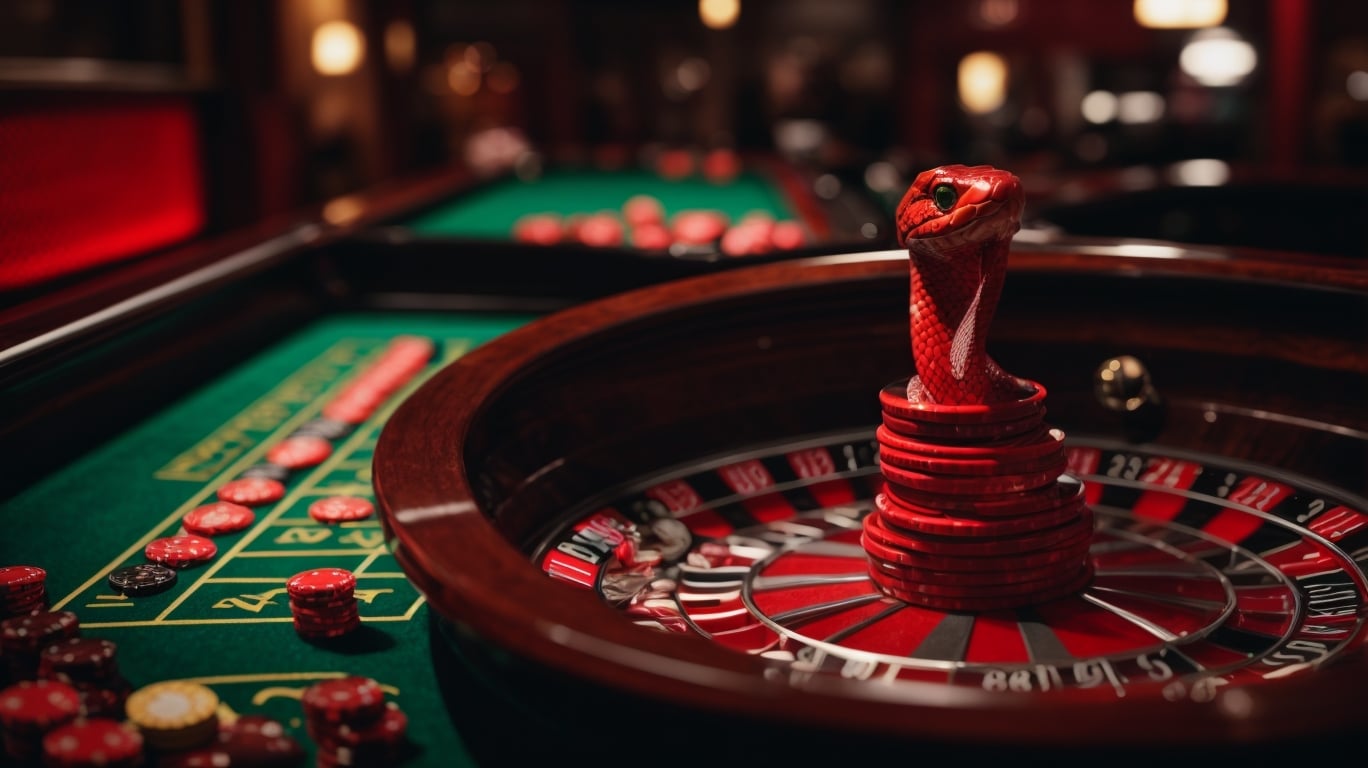The Curious Case of the Red Snake Bet Roulette Strategy
If you’re a roulette enthusiast looking for a unique and potentially rewarding strategy, you may want to give the Red Snake Bet a try. This strategy is a variation of the famous “snake bet” and involves placing bets on red numbers on the roulette table.
How the Red Snake Bet Works
The Red Snake Bet is relatively straightforward. It involves placing bets on consecutive red numbers in the snake-like pattern on the roulette table. The pattern starts with the first red number and continues to the last red number on the table, covering 12 numbers.
The Red Snake Bet provides an exciting and engaging playing strategy, allowing you to cover a significant portion of the table and potentially increase your chances of winning. However, like any roulette strategy, it’s important to remember that this is still a game of chance, and there are no guarantees of winning.
While the Red Snake Bet offers a unique way to play roulette, it’s important to mention that it does not alter the odds or the house edge. The strategy provides a structured approach to placing bets, and it’s up to luck to determine the outcome.
In conclusion, the Red Snake Bet is an exciting roulette strategy that can add excitement to your gameplay. If you’re looking for a new approach to betting on red numbers, try it and see how it works for you. Just remember to play responsibly and enjoy the thrill of the game.
The Strategy Behind the Red Snake Bet
Why the Red Snake Bet is Considered Curious
The Red Snake Bet is a unique and intriguing strategy that has gained popularity among roulette enthusiasts. This strategy involves placing a series of bets that form a snake-like pattern on the roulette table, with all the bets being placed on red numbers. The strategy gets its name from the distinctive shape that these bets create on the betting layout.
The Red Snake Bet’s combination of risk and potential reward makes it curious. While it offers the thrill of covering a large portion of the roulette wheel with the possibility of a significant payout, it also risks losing all the bets if the ball lands on a black number. This high-risk, high-reward nature makes it an exciting strategy for players looking to take a chance and break away from more traditional betting approaches.
Exploring the Probabilities and Intuition Involved
To understand the Red Snake Bet strategy, one must consider the probabilities and intuition behind it. Placing bets on red numbers covers almost half of the roulette wheel, providing a good chance of winning. However, it is crucial to recognize that the odds of hitting a red number on each individual spin remain the same, regardless of previous outcomes. The key is to trust one’s intuition and accept the element of chance involved in roulette.
Players need to exercise caution when using the Red Snake Bet strategy. While it can be an exhilarating approach, it is still a game of chance, and there is no foolproof strategy to guarantee success. Players should set a budget, play responsibly, and enjoy the excitement of the game without relying entirely on any specific betting strategy.
By considering the curious nature of the Red Snake Bet strategy and understanding the probabilities and intuition involved, players can approach roulette with a sense of adventure while maintaining a realistic outlook on the potential risks and rewards.
The Mechanics of Placing a Red Snake Bet

If you’re a roulette fan and want to try a unique betting strategy, you may have encountered the Red Snake Bet. This strategy involves placing bets in a specific pattern on the roulette table, creating a visually striking snake-like layout. But how does it work? Let’s break it down.
Steps to Create the Snake Pattern on the Roulette Table
- Identify the Red Numbers: To create the snake pattern, you first need to locate the red numbers on the roulette table. These numbers include 1, 5, 9, 12, 14, 16, 19, 23, 27, 30, 32, and 34.
- Place Your Bets: Once you’ve identified the red numbers, you can start placing your bets. Place a chip on each red number mentioned above, creating a winding snake-like pattern across the table.
- Manage Your Bankroll: It’s important to remember that roulette is a game of chance, and there’s no guaranteed winning strategy. So, make sure to manage your bankroll wisely and only bet what you can afford to lose.
Odds of Winning and Payouts for the Red Snake Bet
The Red Snake Bet is an exciting strategy, but it’s essential to understand the odds and payouts associated with it.
- Odds of Winning: The Red Snake Bet covers 12 out of the 37 possible outcomes on a European roulette wheel, resulting in a 32.4% chance of winning. On an American roulette wheel with 38 numbers, the odds of winning decrease slightly to 31.6%.
- Payouts: If the ball lands on any red numbers covered by the Red Snake Bet, you’ll be paid out at a rate of 2 to 1. This means that for every dollar you bet, you’ll receive two dollars in winnings if your bet is successful.
So, if you want to spice up your roulette experience and try a new betting strategy, the Red Snake Bet could be worth a try. Just remember to play responsibly and enjoy the thrill of the game!
The Cultural Perspective of the Red Snake Bet
Have you ever heard of the Red Snake Bet roulette strategy? It’s a unique betting technique that has gained popularity among gamblers worldwide. But where did it come from, and why is it called the Red Snake Bet? Let’s delve into the cultural perspective behind this intriguing strategy.
The Origins of the Red Snake Bet
The Red Snake Bet is believed to have originated in Chinese gambling culture. It is a variation of the famous “Snake Bet” in roulette, where players bet on a sequence of numbers that resemble a snake. The addition of the color red to the bet is what distinguishes it and gives it its name.
The Significance of Red and the Snake in Chinese Culture
In Chinese culture, the color red holds great importance. It is associated with good luck, wealth, and prosperity. Red is a symbol of joy and celebration and is often used during special occasions, such as weddings and the Chinese New Year.
On the other hand, the snake is considered a powerful and auspicious animal in Chinese mythology. It symbolizes intelligence, wisdom, and transformation. The snake is also associated with good fortune and is believed to bring luck and success.
The Red Snake Bet strategy taps into these cultural beliefs and superstitions by combining the color red and the snake. It adds an extra element of excitement and luck to the game, making it more enticing for players.
Overall, the Red Snake Bet roulette strategy offers a fascinating cultural perspective on the roulette game. It not only adds a unique twist to the betting experience but also draws upon Chinese culture’s rich symbolism and beliefs.
Conclusion
The Curious Case of the Red Snake Bet Roulette Strategy brings an exciting perspective to the world of gambling. While some individuals swear by this strategy, it’s essential to approach it with caution and a realistic understanding of its effectiveness.
Evaluating the Effectiveness of the Red Snake Bet Roulette Strategy
When evaluating the effectiveness of any gambling strategy, it’s important to consider the mathematical odds and probabilities involved. While the Red Snake Bet may seem promising, it ultimately relies on luck rather than a proven method for consistently winning.
Considering the Cultural Context of the Bet
It’s also important to consider the cultural context in which the Red Snake Bet strategy originated. Gambling traditions and superstitions can vary significantly between different cultures. While the Red Snake Bet may hold significance in certain regions, it’s essential to understand that its effectiveness may not extend universally.
In conclusion, the Red Snake Bet Roulette Strategy is an intriguing concept that may appeal to those seeking a unique approach to their gambling endeavors. However, it’s crucial to approach any gambling strategy cautiously and be aware of the limitations and risks involved. Always remember to gamble responsibly and within your means.


